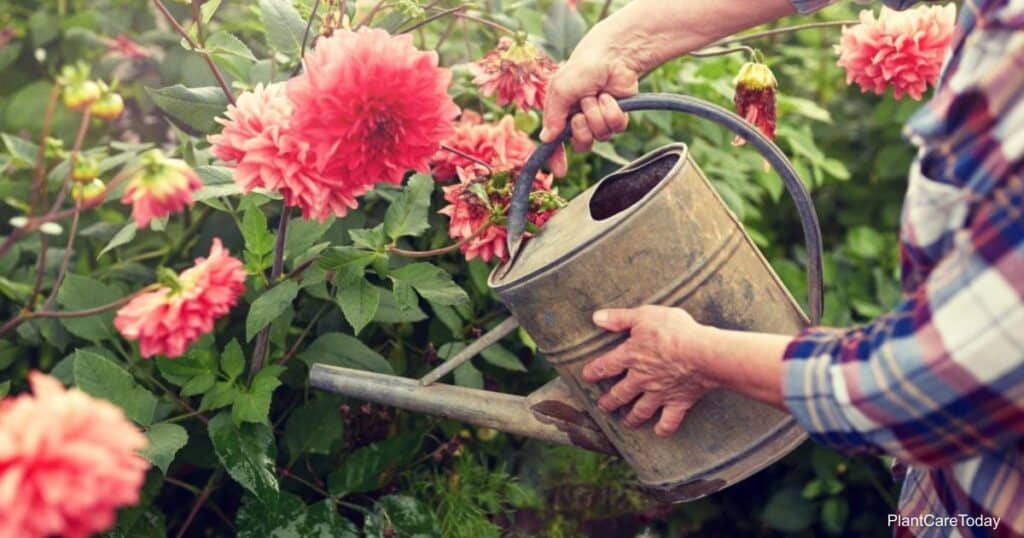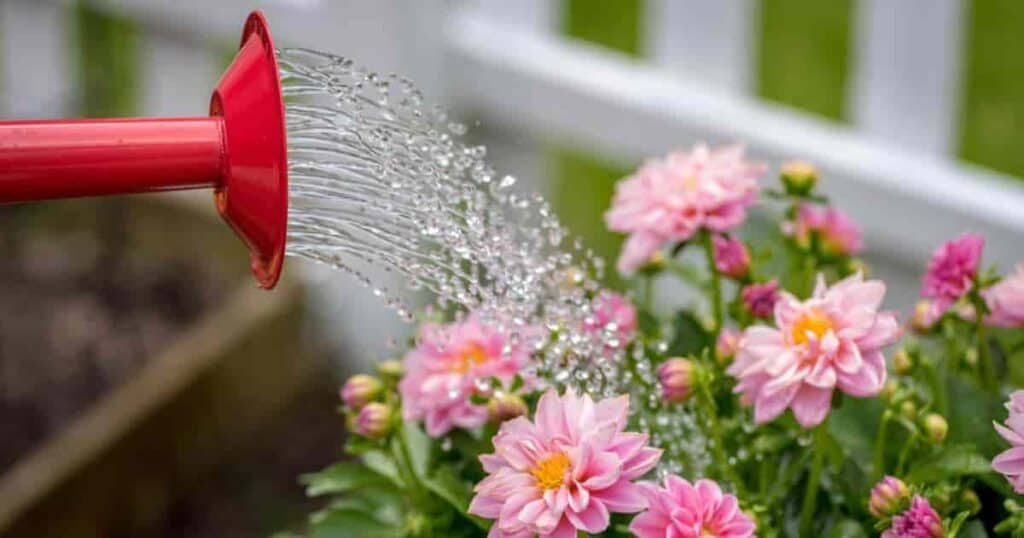With well over 57,000 cultivars and 42 recognized species, there’s seemingly no end to the potential variations in dahlias.
However, they all share essentially the same care requirements, making it equally easy to care for a pompon dahlia or single dahlia.

Proper watering is perhaps the single most important care aspect, as most of the problems your dahlia will face are due to poor watering habits.
Dahlia Watering: How To Water Dahlia Plants
The soak-and-dry method is by far the easiest way to ensure dahlias get just the right amount of moisture.
Knowing how to identify when your plant may be getting too much or too little is a vital part of ensuring a healthy and robust dahlia plant.

The Risks Of Overwatering
Too much water is almost always the culprit of your dahlia falling ill.
The leaves may become limp and feel soggy to the touch, or blisters might form.
Root rot and stem rot could set in, both of which can be deadly on their own.
Many Dahlia pests, such as aphids, fungus gnats, and thrips are attracted to the excess moisture and may bring with them fungal infections or deadly diseases such as mosaic virus and verticillium wilt.
Whether growing Dahlia in a pot or in the ground, you can often tell your dahlia is getting too much water if the soil feels wet or soggy.
The Risks Of Underwatering
On the other end of the spectrum, too little water can also have consequences.
The Dahlia leaves may turn yellow and feel dry or even crispy to the touch.
Blooms may fail to open and the plant may suffer stunted growth or wilting.
Worst of all, your plant uses 97 to 99% percent or more of its water for a process called transpiration which is similar to sweating.
When the plant doesn’t get enough water, it can’t properly transpire and may wilt more quickly if the humidity is low.
When you see such symptoms, be sure to check the soil.
If it feels dry, even when you stick your finger in, the plant is probably dehydrated.
Ensuring Good Drainage
Before you even plant your dahlia, it’s a good idea to ensure the soil is well-draining.
Clay soils can often not only have poor drainage but also lack acidity.
You’ll want to work in some organic compost to help combat both problems.
Additionally, you should add an aggregate such as perlite or coarse sand to keep the soil from compacting.
Another good trick is to add a substrate layer of gravel to a container or excavated garden spot prior to planting the tuber.
This layer serves as a buffer zone in the event the water isn’t draining properly.
The Soak And Dry Method
This is perhaps the single best watering technique out there, and it works wonders for plants such as dahlias.
As a general rule, an outdoor dahlia will need 1” inch of rainfall per week.
However, environmental conditions, such as higher or lower temperatures and amount of sunlight can affect how quickly your dahlia’s soil dries out.
To use the soak and dry method, feel the soil underneath the plant.
- If the soil feels moist but not wet, the plant has enough water.
- If it feels soggy or wet, the soil needs time to dry out.
- But if the soil is dry to the touch (or 1” inch down for potted plants), it’s time to water.
- Getting as close as you can to the base of the plant, pour room temperature water slowly and evenly.
- This gives the soil time to absorb the water.
Potted plants will be saturated when moisture begins to seep from the drainage holes, while ground watering should stop when the ground begins absorbing slower than you’re watering.
Additional Watering Tips
Try to avoid getting water on the leaves and flowers, as this can lead to fungal infections (although natural rainfall is okay).
In the event you must water from overhead, do so early in the morning so the plant has time to air dry before it gets too hot or sunny.
Trim the lowest branches of the plant to encourage airflow to help prevent fungal infections.
In case of drought, protect the ground around the dahlia from drying out with some mulch.
Tubers don’t need to be watered when they’re first planted.
Likewise, you should cut back on watering in the autumn and winter as dahlias prefer this time to go dormant.
Sprinklers and other forms of artificial irrigation save time but are inefficient when it comes to watering evenly, so it’s best to water by hand whenever possible.
